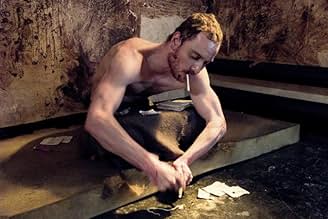Bobby Sands, un republicano irlandés lidera a los reclusos de la prisión de Irlanda del norte en una huelga de hambre.Bobby Sands, un republicano irlandés lidera a los reclusos de la prisión de Irlanda del norte en una huelga de hambre.Bobby Sands, un republicano irlandés lidera a los reclusos de la prisión de Irlanda del norte en una huelga de hambre.
- Ganó 1 premio BAFTA
- 49 premios ganados y 39 nominaciones en total
- Dirección
- Guionistas
- Todo el elenco y el equipo
- Producción, taquilla y más en IMDbPro
Argumento
¿Sabías que…?
- TriviaHunger is known for its unbroken 17 minute 10 second continuous shot, in which Catholic priest Father Dominic Moran tries to talk Bobby Sands out of the Hunger Strike he and his fellow 75 IRA members plan to start. The camera remains in the same position throughout the scene. To prepare, Liam Cunningham moved into Michael Fassbender's apartment, and they rehearsed the scene 12-15 times per day. On the first day of filming, the actors got it perfect after 4 takes.
- ErroresRaymond Lohan's Ford Granada is a Mk2 Facelift, which was released in winter 1981 and would've appeared on Irish roads in 1982.
- Citas
Bobby Sands: I have my belief, and in all its simplicity that is the most powerful thing.
- ConexionesFeatured in Front Row: Michael Fassbender/Kate Winslet (2017)
- Bandas sonorasIndustry
Performed by Maya Beiser
Composed by Michael Gordon
Published by Red Poppy in association with G. Schirmir, Inc.
Opinión destacada
Hunger is a powerful and disturbing feature-film debut for the visual artist Steve McQueen. The film takes place almost exclusively within the confines of a high-security prison in Northern Ireland, where many members of the Irish Republican Army are interned. The small confines of the prison serve as a microcosm of the wider Troubles in Ireland. The conflict between the British wardens and the Irish inmates escalates steadily, with each indignity and abuse inevitably leading to another.
The conditions revealed in the prison are deeply disturbing, with the inmates fouling the jail with effluent and the guards responding with ritual humiliation and savage beatings. McQueen's camera is an unflinching witness to the squalor and cruelty, and with the vivid imagery and forceful sounds it is almost possible to smell and feel the frightening environs of the film.
Although the focus of the film ultimately falls on Bobby Sands, the IRA member and inmate who leads a fatal hunger strike within the prison, we are not introduced to the main protagonist until a third of the way through the film. This approach works remarkably well in setting the scene for the main narrative, but it is disappointing that the different perspectives on each side are somewhat sidelined thereafter, as Sands's personal struggle takes centre stage.
The terrible squalor of the prison cells provides some of the film's most powerful images, but it is the second third of the film that is the most gripping, as Sands converses and argues with a visiting Catholic priest. An unmoving camera is trained upon these two protagonists for what must be nearly half an hour, as Sands reveals his plan for a new hunger strike and defends his methods of achieving political goals, ultimately berating what he sees as the priest's despondency and inertia. This is an utterly compelling piece of cinema.
However, at the end of this gripping conversation, the director sees fit to insert a somewhat tortured analogy as Sands recalls for the priest a defining moment of his boyhood. This is an unnecessary effort to inject conventional beauty into Sands's story, and sits awkwardly with the general tone of the film.
In the final third of the film, the hunger strike is depicted in by now characteristically brutal detail. Lead man Michael Fassbender clearly underwent a very painful regime to portray the wasting and withering of Bobby Sands in his last days. Unfortunately, amidst the impressive attention to detail, McQueen goes further in romanticising his main protagonist through a series of flashbacks to Sands's childhood. This again jars with the realistic feel of the rest of the film, and points to McQueen's obsession with Sands, which he has admitted to having had since a young age.
Although at times steering a little close to hagiography, McQueen's directorial debut is still a bold and engrossing film that cultivates an understanding for the very different people caught in up in the Troubles in Northern Ireland. It will be fascinating to see what his next project will be.
The conditions revealed in the prison are deeply disturbing, with the inmates fouling the jail with effluent and the guards responding with ritual humiliation and savage beatings. McQueen's camera is an unflinching witness to the squalor and cruelty, and with the vivid imagery and forceful sounds it is almost possible to smell and feel the frightening environs of the film.
Although the focus of the film ultimately falls on Bobby Sands, the IRA member and inmate who leads a fatal hunger strike within the prison, we are not introduced to the main protagonist until a third of the way through the film. This approach works remarkably well in setting the scene for the main narrative, but it is disappointing that the different perspectives on each side are somewhat sidelined thereafter, as Sands's personal struggle takes centre stage.
The terrible squalor of the prison cells provides some of the film's most powerful images, but it is the second third of the film that is the most gripping, as Sands converses and argues with a visiting Catholic priest. An unmoving camera is trained upon these two protagonists for what must be nearly half an hour, as Sands reveals his plan for a new hunger strike and defends his methods of achieving political goals, ultimately berating what he sees as the priest's despondency and inertia. This is an utterly compelling piece of cinema.
However, at the end of this gripping conversation, the director sees fit to insert a somewhat tortured analogy as Sands recalls for the priest a defining moment of his boyhood. This is an unnecessary effort to inject conventional beauty into Sands's story, and sits awkwardly with the general tone of the film.
In the final third of the film, the hunger strike is depicted in by now characteristically brutal detail. Lead man Michael Fassbender clearly underwent a very painful regime to portray the wasting and withering of Bobby Sands in his last days. Unfortunately, amidst the impressive attention to detail, McQueen goes further in romanticising his main protagonist through a series of flashbacks to Sands's childhood. This again jars with the realistic feel of the rest of the film, and points to McQueen's obsession with Sands, which he has admitted to having had since a young age.
Although at times steering a little close to hagiography, McQueen's directorial debut is still a bold and engrossing film that cultivates an understanding for the very different people caught in up in the Troubles in Northern Ireland. It will be fascinating to see what his next project will be.
- Robert_Woodward
- 14 nov 2008
- Enlace permanente
Selecciones populares
Inicia sesión para calificar y agrega a la lista de videos para obtener recomendaciones personalizadas
Detalles
- Fecha de lanzamiento
- Países de origen
- Sitio oficial
- Idiomas
- También se conoce como
- Tù Khổ Sai
- Locaciones de filmación
- Productoras
- Ver más créditos de la compañía en IMDbPro
Taquilla
- Presupuesto
- GBP 1,500,000 (estimado)
- Total en EE. UU. y Canadá
- USD 154,084
- Fin de semana de estreno en EE. UU. y Canadá
- USD 1,980
- 7 dic 2008
- Total a nivel mundial
- USD 3,185,113
- Tiempo de ejecución1 hora 36 minutos
- Color
- Mezcla de sonido
- Relación de aspecto
- 2.35 : 1
Contribuir a esta página
Sugiere una edición o agrega el contenido que falta

Principales brechas de datos
By what name was Hunger (2008) officially released in India in Hindi?
Responda





















